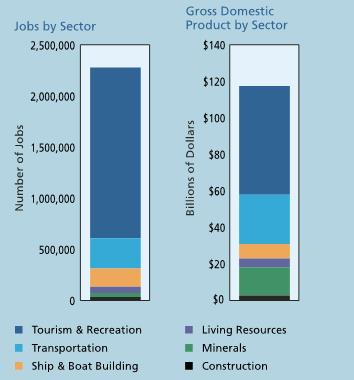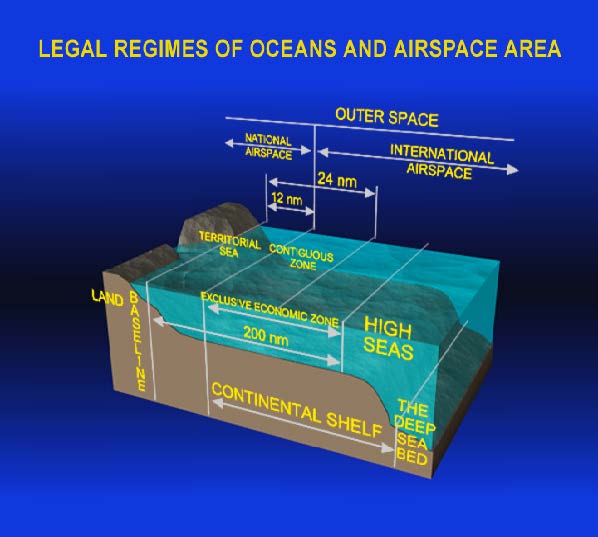Unit 1 – Our Public Oceans
Our Public Oceans
Contents
Introduction
The Public Trust Doctrine
Boundaries: Coastal Waters, the Territorial Sea, and the Contiguous Zone
The Exclusive Economic Zone or EEZ
The Roles of Federal and State Government in American Ocean Management
A Closer Look at Offshore Uses and Players
Introduction
The oceans cover some three-quarters of the Earth. The United States (U.S.) alone governs an ocean area—consisting of both water and land below the surface–over three million square miles, more extensive than the fifty states’ land area. U.S. management spans fisheries, wildlife, energy and minerals, telecommunications, shipping and transportation, weather prediction, military training and national security on behalf of the people of the U.S., who are the ocean’s owners. Even single-sector management, such as fisheries, is complex and involves many different laws and government players that have the challenging goal of balancing conservation with resource harvest or extraction. Many different agencies and personnel are involved in ocean law and policy; many former students are now professionals within this fascinating management mosaic. Let’s get started on our quest to develop a foundation for ocean law knowledge by beginning to understand how things fit together.
Collectively, the oceans are estimated by the United Nations to represent assets equivalent to the seventh largest economy in the world. Within a single nation, such as the United States, the coasts and oceans represent a vast and diverse wealth in terms of living and nonliving resources, jobs, recreation and cultural amenities. The ocean economy is complex and difficult to measure. According to the US Ocean Commission’s 2004 Final Report, values that are critical but evade measure include intangibles such as “clean water, safe seafood, healthy habitats, and desirable living and recreational environments,” a lack of information the Report says have prevented full appreciation by Americans of the economic importance of oceans and coasts. The Report also notes, for comparison, that while the US spends $100 million annually on economic research on agriculture, ocean-related employment (two million jobs, $117 billion) is 1.5 times than agricultural employment (2000) and the economic output of the ocean economy in 2000 was 2.5 times larger than that of agriculture.

A major feature of the ocean economy pertinent to ocean law study is that the nations’ oceans are owned by its citizens.
The Public Trust Doctrine
One of the most interesting and unique management aspects of the oceans is that they are ours and cannot be privately owned. This has several important implications for how we take care of, use, and impact ocean ecosystems and marine resources. For public ownership of the oceans, we have an ancient legal doctrine to thank: the Public Trust Doctrine. The Public Trust Doctrine began as part of the Institutes of Justinian, a Byzantine Roman emperor who codified (made into law) the concept in the year 533. The Institutes had the force of law, and in fact served as the learning materials for first year law students for hundreds of years! Justinian’s laws included, for our purposes, that no one could own the air, shoreline (seaward of the high water mark), the sea bed, oceans waters, running rivers or the resources of animals therein. The sovereign holds these resources in trust for the people of the nation.

This Public Trust carries affirmative legal duties, the same as any form of modern trust, as in a family trust managed by a financial institution. The Public Trustee (the sovereign government) has the duty to conserve and protect the contents of the Trust: the duty not to commit waste of the Trust’s resources, and so forth.
The Public Trust Doctrine eventually became part of English common law, the basis for our own case law in the United States. Far from remaining a static or stale ancient doctrine, the conceptual framework of the Public Trust continues to evolve. The most important thing you need to remember for our explorations in this course is that the public maintains a powerful and defensible legal interest in coastal waters (where the sovereign trustee is the coastal state government), the oceans, their ecosystems and their resources (living and nonliving). For example, if a coastal state leases a parcel of its seabed for the purpose of anchoring a device to harvest ocean energy such as from wind or waves, on behalf of its citizens the state must collect a fair rent through a lease. Similarly, for activities in federal waters petroleum companies must, under law, provide a “fair return in value” of resources extracted from the outer continental shelf to the American people via the United States Treasury, because these are public resources that government manages on the public’s behalf.
Boundaries: Coastal Waters, the Territorial Sea, and the Contiguous Zone
In the United States, there are 35 coastal states — we include the states bordering the Great Lakes. In most cases, each coastal state manages its waters out to three nautical miles off shore (a nautical mile is the equivalent of 1.508 geographic miles). The three-mile zone is commonly understood to derive from the practical necessity of defending the coastline—three miles is the distance a cannon could be effectively fired in the nation’s colonial period.
There are narrow exceptions (Florida’s Gulf coast and Texas have nine-mile limits, as does Puerto Rico) due to particular historical foundations. If you are interested in geographical boundaries and would like to learn more, take a look at the U.S. Ocean Commission’s report: “An Ocean Blueprint for the 21st-Century, Primer on Ocean Jurisdictions: Drawing Lines in the Water.”
Each state governs the resources within its state waters in accordance with the Coastal Zone Management Act (CZMA) of 1972 (16 United States Code [abbreviated USC] Sections [marked §§ 1451-1464, Chapter 33).
The next boundaries to be aware of are the US Territorial Sea, and the adjacent Contiguous Zone (the boundary is 24 miles off shore). Be aware that the term territorial sea can be confusing because the states can use the term to describe coastal state waters (the three-mile zone). However, the US Territorial Sea extends to 12 nautical miles and pre-dates the Truman Proclamation (Proclamation 2667, see http://cclme.org/viewcontents/?f=1-USCFR-truman.txt (1945) asserting US jurisdiction beyond the (previous) twelve-mile limit to the United States’ adjacent continental shelf.

The Exclusive Economic Zone or EEZ
President Ronald Reagan established the United States’ Exclusive Economic Zone (EEZ, 200 nautical miles off shore) by Proclamation 5030 following international law and custom (established by the United Nations Convention on the Law of the Sea, UNCLOS) in 1982. The 200-mile zone encompasses United States national waters.
You can view Proclamation 5030. For further background on the EEZ, browse on the National Ocean Service website.
It is staggering to realize the management and law enforcement implications of the US’ EEZ’s vast area, which includes not only the range within 200 miles of our continental coastline but also the 200-mile zone surrounding Hawai’i and United States Territories (Guam, Northern Mariana Islands, Wake Island, Howland and Baker Islands, Midway Islands, Johnston Atoll, Palmyra Atoll, Kingman Reef, Jarvis Island, American Samoa, Navassa Island, Puerto Rico, and the US Virgin Islands). The coastline of the US is 13000 miles long; the area within the US’ EEZ is roughly 3.4 million square nautical miles. Within this area lay vast living and nonliving resources including fisheries, wildlife, seabed minerals, and energy potential (including wind and wave energy).

Under international law, each nation has affirmative mandatory legal duties, beginning with conservation, in the seabed and water column within its EEZ. What rights does the Exclusive Economic Zone impart to the United States? There are three major categories of rights that nations possess in their EEZs. These sovereign rights include exploration/exploitation (but not over-exploitation) of living and nonliving resources, jurisdiction for law enforcement (domestic and international), and other rights defined by international law. Regulatory rights include marine scientific research, and prevention of pollution and dumping. Finally, within their EEZs nations have the right to create artificial islands or other structures with 500-meter safety zones. Unit 6 will discuss responsibilities and rights embodied in UNCLOS as it pertains to international fisheries management within nations’ EEZs.
The open ocean beyond each nation’s EEZ is known as the high seas, or international waters.
Historically, oceans all over the world were freely open to navigation and fishing for all, under a doctrine called Mare Liberum (Latin for “Freedom of the Seas”). This concept appears in a book published in 1609 by Dutch jurist Hugo Grotius. Grotius’ claim was, in part, made in order to justify Dutch exploration of the East Indies.
Today, key points to keep in mind relevant to freedom of navigation, the Territorial Sea, and the EEZ include: 1) a federal navigation servitude derived from the commerce clause within the United States Constitution, the customary right of innocent passage, and 2) a nation’s right to enforce its laws and protect its economic interests. Navigation is so critical to the public interest, that the federal government can order structures that impede navigation removed without compensation under the navigation servitude, the authority governing navigation in all navigable waters. States may also claim state navigation servitudes in state waters under their police power. While state servitudes vary slightly, the main idea is that no compensation is due landowners if structures were removed for a public purpose, including access to riparian areas or for navigation. State navigation servitudes are subject to the supremacy of the federal servitude.
Freedom of navigation is still a customary right, but has been necessarily curtailed by modern international law. Prior to the US’ establishment of a 200-mile EEZ, it was fairly common to see fishing fleets from other nations from shore with the naked eye. Civilian (not military) foreign vessels may travel (a right known as innocent passage) through the 12-mile Territorial Sea or even the EEZ if they obey applicable laws and are not interfering with the sovereign nation’s economic rights. The EEZ prioritizes fishing, as all other economic activities, to US vessels.
Beyond the nation’s 200-mile EEZ lay the high seas. The high seas are interesting as a topic for research and discussion in terms of international law, exploration, scientific research, conservation, piracy (including illegal, undocumented, and unregulated, IUU fishing) and law enforcement. A good place to learn more about the high seas is by viewing a TED talk by expert Kristina Gjerde. The United States Coast Guard is tasked with law enforcement in US waters and on the high seas. For a detailed summary of the topic generally, see the paper by Commander Jeffrey Randall, USCG, Ready for Future? The US Coast Guard and 21st Century Law Enforcement on the High Seas at http://brook.gs/2bFmSiB. For more information on fisheries law enforcement on the high seas, take a look at this site http://www.fao.org/newsroom/en/focus/2004/47127/article_47140en.html hosted by the United Nations Food and Agriculture Organization (FAO).
The Roles of Federal and State Government in American Ocean Management
Coastal states maintain jurisdiction in their coastal waters and resources, subject to preemption by the federal government in constitutionally reserved jurisdictional areas that historically include navigation (via the navigation servitude), energy, commerce, international treaties, military matters and national security. State police powers extend to persons, geographic areas, and resources within their boundaries, which include coastal waters.
Under the Coastal Zone Management Act’s consistency provisions, activities offshore that require a federal permit (referred to as federally permitted activities) must be consistent with the adjacent state’s coastal management plan. States may even assert concurrent jurisdiction in activities or resources beyond their own coastal waters (including federally permitted activities in adjacent states’ waters) if they can show the activities will foreseeably impact their own waters, resources or citizens. An example of when a state might assert jurisdiction is for the siting of an offshore energy facility adjacent to the state but outside the three nautical mile zone.
With regard to fisheries management, state programs maintain licensing for sport and commercial fisheries within their waters and also regulate mariculture (fish farming) within their waters. If the federal regional fisheries management agency does not have a management plan for certain fish species, states may even regulate their licensed vessels in the relevant fishery outside of the three-mile line.
State fish and wildlife agencies police state coastal waters to enforce fisheries laws. In the case of species that are also federally managed, such as endangered species and marine mammals, law enforcement is a joint effort, led by federal enforcement officials.
As we will see in the unit on fisheries management, states also participate in the eight national regional management councils by having a seat at their regional decision-making table. Particularly more recently, coastal states are leading in management innovations in fisheries management, ecosystem-based management, and the establishment of marine protected areas, as well as coastal zone management and conservation, convening ocean science boards and other advances.
In state waters, coastal state and federal managers also collaborate with regard to species protected under federal law, particularly under the Endangered Species Act and Marine Mammal Protection Act.
Finally, states work together with federal authorities on matters involving coastal water quality management: assessing pollutants, prioritizing water quality issues, reporting, and enforcing standards under the Clean Water Act of 1972 (33 USC §1251 et seq.). States may prohibit the dumping of ballast water containing invasive species in their waters, or prohibit ships from dumping sewage under Section 402 of the CWA regulating discharges from discrete sources or pipes (the National Pollutant Discharge Elimination System, NPDES, 33 USC §1342) as well as the Rivers and Harbors Act. Other examples of cooperative state and federal management will be discussed.
A Closer Look at Offshore Uses and Players
The view from any beach in the United States (including those of the five Great Lakes: Lakes Eerie, Huron, Michigan, Ontario, and Superior included in NOAA’s coastal management programs) seems uncluttered and unencumbered. Ocean law study involves becoming aware of the many activities, uses, laws and regulations, and management entities involved offshore.
The governments involved range from coastal counties (and even cities in certain instances), state agencies, and federal agencies. Among them, they share various significant responsibilities of governing living and nonliving resources from the shore, within the state coastal zone, and federal waters beyond, representing public and private access, coastal development, forestry, fishing, conservation, recreation, public health, mineral resources such as sand and gravel, and protecting coastal communities from coastal hazards. The following diagram, from the Oregon Territorial Sea Plan, provides a glimpse into how these responsibilities are organized and distributed within a specific coastal state context as an example.

Key to the Acronyms in Figure 1.5
Left to Right in the Illustration:
- ODLCD: Oregon Department of Land Conservation and Development
- USEPA: United States Environmental Protection Agency
- USCG: United States Coast Guard, also in charge of drug interdiction
- ODOGMI: Oregon Department of Geology and Mineral Industries
- NMFS: National Marine Fisheries Service (of NOAA)
- USFWS: United States Fish and Wildlife Service (within the US United States Department of the Interior, or DOI)
- ODFW: Oregon Department of Fish and Wildlife
- ODSL: Oregon Department of State Lands
- USFAA: United States Federal Aviation Administration
- ODEQ: Oregon Department of Environmental Quality
- OSMB: Oregon State Marine Board
- OPRD: Oregon Parks and Recreation Department
- USFS: United States Forest Service (within the US Department of Agriculture or USDA)
- USCOE: United States Army Corps of Engineers (USACE, the Corps; within the Army)
- OHD: Oregon Health Department
- ODOA: Oregon Department of Agriculture
- USBLM: United States Bureau of Land Management (within the United States Department of the Interior, or DOI)
An appendix of Resources at the end of the book contains additional details about these agencies (see resources for unit one) as well as other information pertinent to ocean law.
Unit 2 will discuss the regulation and management of specific species under the Endangered Species Act and Marine Mammal Protection Act.
Unit 1 Study Questions
- What are some contemporary implications of public ownership of the oceans and their resources?
- Why do you think we maintain the Public Trust Doctrine? What is the Trust property being protected? Who is the Trustee in state waters? Who is the Trustee in federal waters?
- Who are the Trust beneficiaries?
- What might be some effects if areas of the ocean were to be opened to privatization?
- Can you think of analogies to how the ocean is managed from land management?
- When President Reagan issued Executive Order 5030, what did the United States gain? What are some of the implications for law enforcement and resource management of an area that is larger than the land area of the fifty states? What are the significant differences between land and ocean management?

